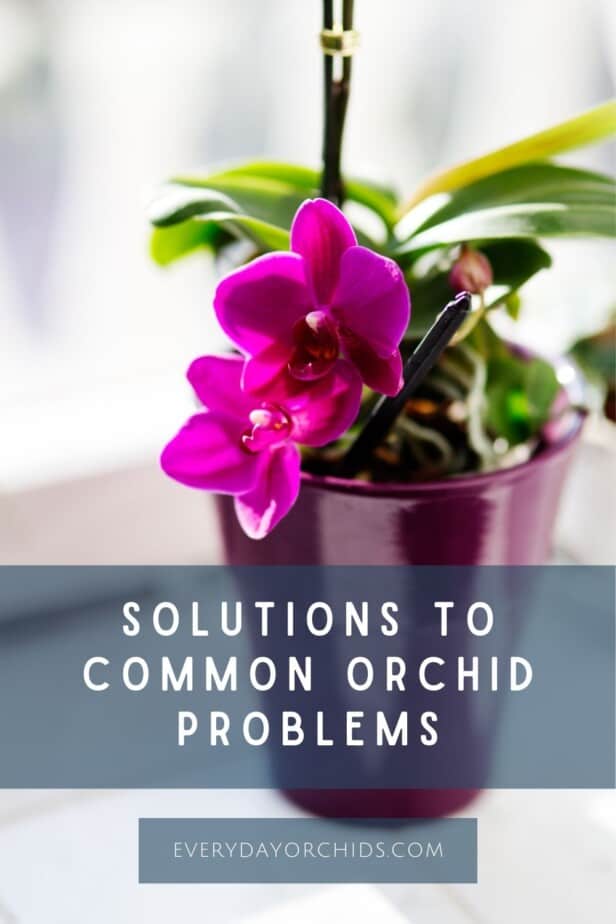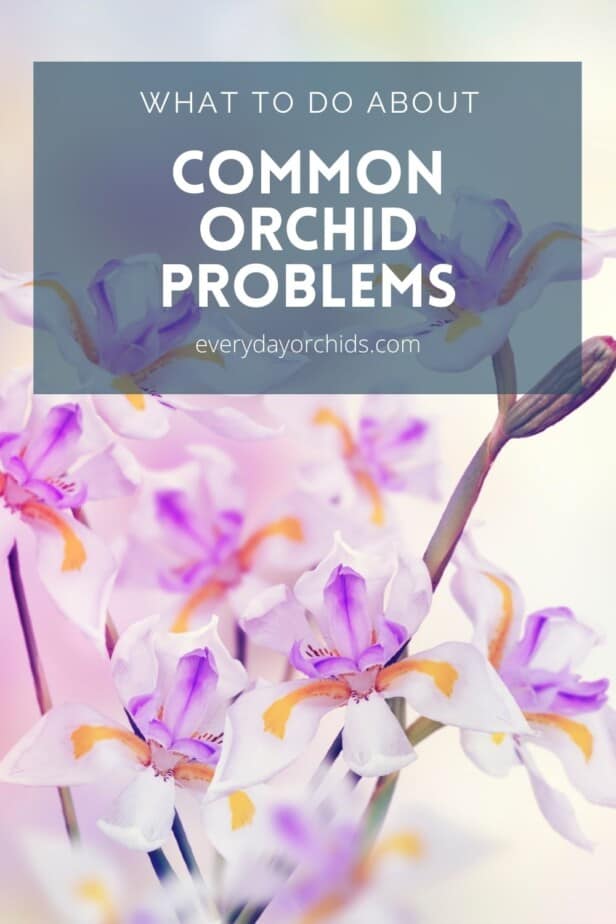Growing orchids is not always easy and there are a variety of different problems that could arise. Aside from giving them the basic care that is required, you may find that orchids can be susceptible to a whole host of issues. In order to successfully care for your orchids, you will need to take steps to identify and fix these problems.
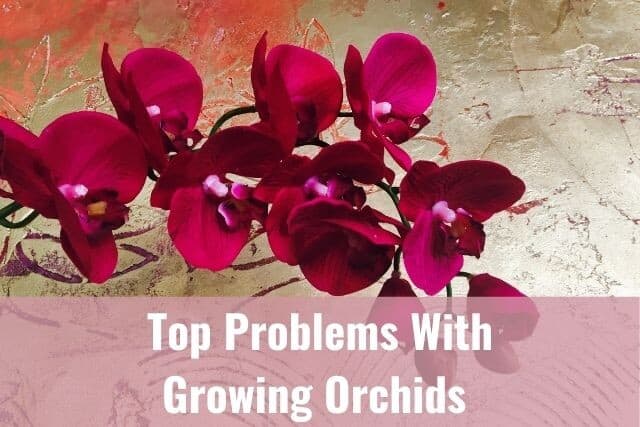
The top problems you will encounter when growing orchids include stems turning brown or yellow, roots rotting, and leaves changing colors and textures. There are also problems related to pests and plant diseases. The key is to spot these issues early on and determine the underlying cause so you can properly treat them and bring your orchid back to health.
In this article, I will discuss some of the most common issues you will encounter when growing orchids. I will also talk about what causes these problems when growing orchids and how you can treat them effectively.
Please note that these links are affiliate links and as an Amazon Associate, I earn from qualifying purchases. Purchases made through affiliate links in this post may generate commissions at no additional cost to you. Use this link for a discounted Amazon Prime trial. Thank you for your support!
Table of Contents
Orchid Leaves Changing Color
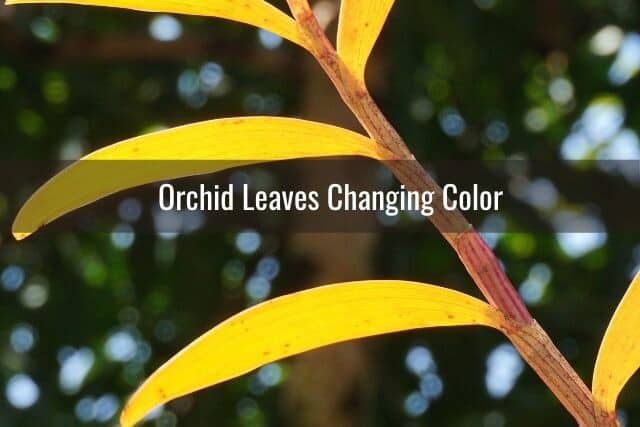
Healthy orchid leaves are a medium grassy green color. When the leaves change colors, this can be a telltale sign of a more serious problem.
Orchid leaves can change color due to dehydration, over or under watering, lighting, sunburn or heat damage. You may also see spots on the leaves due to pest infestations, fungal or bacterial infection, sunburn or heat damage, and fertilization issues.
Remember that orchid leaves changing color is the most easily noticeable indicator of problems regarding your orchid’s health and its environment. Instead of treating just the leaves or removing them, you will need to figure out what the underlying problem is and treat it in order to bring the plant back to health.
Here is how you can fix leaf discoloration, based on the underlying cause:
Dehydration
Ideally, you should water your orchids once a week or when you notice the potting media is dry. If your orchid goes for too long between waterings, it could get dehydrated. You will see this in your orchid as yellowing, wrinkled, or limp leaves.
The earliest sign of dehydration is leaf discoloration, starting from the tip. If not addressed, the leaf will eventually die. This typically happens one leaf at a time.
The good news is that dehydration is easy to fix. It is also easy to diagnose since you would know whether you have been giving your orchid enough moisture or not. If you have forgotten to water your orchids and don’t know when was the last time you gave them water, all you need to do is rehydrate your plant.
Give your orchid plant a thorough watering, regularly check your potting media, and water again once it is dry to the touch. If the weather is hotter than usual, you may need to water more frequently, such as once or twice a week and increase the humidity around your orchid. You can also use a cool-mist humidifier such as this one, or a humidity tray to keep your orchid hydrated.
Overwatering
Overwatering is a common problem for orchid growers. It is bad for your orchid because overwatering keeps the potting media and your orchid roots wet. Constant exposure to moisture can damage the delicate velamen surrounding your orchid’s roots and lead to root rot.
Since the roots are not readily visible, often times, you will first notice changes in your orchid leaves. In cases of overwatering, the leaves will turn yellow and grow soft and limp.
If you suspect root rot or over watering, you will need to inspect the root system to confirm your suspicions. Take your orchid out from its pot and remove the potting media.
In overwatering situations, the potting media will usually be moist and damp. Rinse the roots to remove any additional potting media that may be clinging to the roots.
If you see black or dark brown roots that are mushy and soggy to the touch, then you have a case of root rot due to excessive moisture. Remove all the rotten and dead roots using a sterilized pair of garden shears or scissors, and leave only the healthy and viable ones.
You can spray the remaining roots with a diluted fungicide such as Physan 20. This will ensure that any fungi or bacteria present in the roots do not infect the remaining roots and cause more damage. When using Physan 20, make sure you dilute it first according to the manufacturer’s instructions. Per their website, they recommend diluting 2 teaspoons of Physan 20 in 1 gallon of water when using this on orchids.
Make sure to get fresh new potting media and a clean pot. Repot your orchid, and be sure not to pack the potting media too tightly. A clear plastic pot would allow sunlight to come in, which will help in forming new roots. The plastic see-through nature of the pot would also allow you to monitor your orchid’s roots. I personally use these clear plastic orchid pots by RepotMe and have found they work well.
Going forward, you will need to be mindful of your watering habits. This means you will need to water your orchid only when the potting media is dry and be careful not to overwater your orchid.
Sunburn or Heat Damage
Exposure to direct sunlight can give your orchid’s leaves sunburn. A portion of the leaf will typically turn yellow first, then become black and dry. The leaf can also turn red around the edges or pale yellow.
In this case, if your orchids are outdoors, you will need to move them to a location with more shade or filtered light and less direct sunlight. Place the orchid where they can still receive bright light, but keep it out of the intense heat of the afternoon sun.
If you are keeping your orchid inside your house, try not to place the orchid next to a glass window.
If the orchid is placed next to a west-facing window, the hot afternoon sunlight can damage the leaves. The close proximity to the window will expose the orchid leaves to the heat. Combined, the intense heat and sunlight can lead to sunburn damage on your orchid’s leaves.
If there is nowhere else you can place your orchid, an alternative would be to put up a sheer curtain or a window cover. This curtain will help filter out the sun’s intense light in the afternoons, reducing your orchid’s risk for sunburn or heat damage, but still allow your orchid to receive bright light.
To learn more, check out this resource on how much light orchids need.
Over Fertilizing or Salt Damage
Over fertilizing your orchids can cause salt build-up in the potting media. This can cause leaves to dry out and turn brown, starting at the tips. The brown discoloration in the leaf tips will spread out to the entire leaf until the leaf dies.
If you have been giving your orchid a full-strength or undiluted fertilizer formula, then it is very likely that over fertilizing is the culprit. This is true even if you have been maintaining proper feeding schedules for the orchid.
If you have discovered over fertilization to be the culprit, you will need to reduce fertilizing your orchids to once or twice a month. Most importantly, make sure to dilute your fertilizer with water to half-strength or quarter-strength concentration, as orchids prefer weak formulation.
It is also important to use orchid-specific fertilizer such as this one. Make it a habit to flush your potting media with rainwater or purified water regularly to help wash off any salts or minerals deposited in there.
If you are interested in learning more, check out this guide on how to fertilize your orchid.
Not Enough or Too Much Light
Orchids thrive in bright, indirect light. That is why a location near a south- or east-facing window is the ideal place for for your indoor orchids. The color of the orchid leaves will be a good indicator of whether your orchids are getting adequate light.
A happy and healthy plant that receives the right amount of light has medium or bright green leaves. Meanwhile, red or yellowish-green leaves indicate that your orchid is getting too much light. Dark green leaves are a signal that your plant is not getting enough light.
If you suspect lighting is the culprit for your orchid’s leaves changing colors, the easiest and quickest solution is to move your plant to an area where they will receive more or less light, depending on the leaf color.
Once you have moved your orchid, you can continue to observe the leaf color as it changes to see if it still needs more or less light.
Bacterial or Fungal Infection
Bacteria or fungi can cause diseases that also cause changes in the color of your orchid’s leaves. These diseases could cause soft or small ringed brown spots or black spots on the orchid’s leaves.
There is a wide variety of these diseases, and the treatment would depend on which one it is that is infecting your plant. Read on to learn about the most common diseases your orchids could encounter and how to treat them.
Orchid Leaves Wilting and Getting Droopy
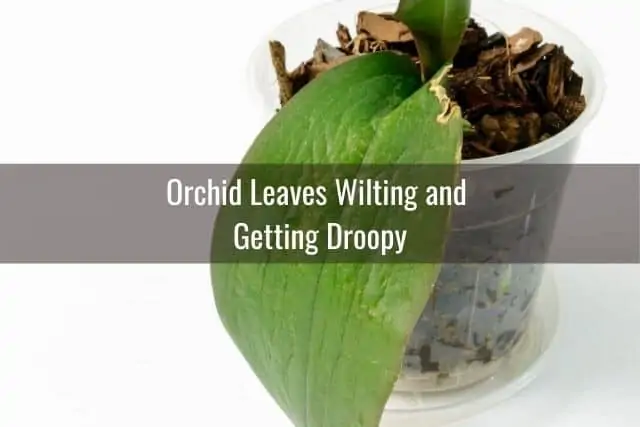
If your orchid’s leaves are wilting and getting droopy, it could mean that your plant is not getting enough humidity or enough water. Since orchids normally thrive in a humid environment, moisture is essential for its healthy growth.
Depending on where you live, you may have to increase the humidity around your plant, especially during the winter. You can do this by using a humidifier, misting the roots or watering your orchid with ice cubes. You can also place a humidity tray, or a tray with stones and water, under the pot.
Wilting and limp or droopy orchid leaves can also be caused by overwatering or certain diseases.
Orchid Stem Changing Color

Another common problem seen when growing orchids are changes in orchid stem color. A normal and healthy orchid stem is green. This color may change to yellow, brown, or red if something is wrong with your plant.
For example, green stems changing to a brighter color such as yellow or red could mean that your plant is getting too much light and is becoming scorched. As such, you will need to relocate your orchid to a different location that receives bright, indirect sunlight.
Stems can also become yellow or brown. This is a signal that your orchid has finished blooming. Usually, this color change occurs after all the flowers have bloomed, wilted and dropped off.
If your flower spike, or stem, has turned brown, dry and shriveled, it is dead. You can safely cut it off without harming your orchid.
The plant uses a significant amount of energy during its flowering stage and sends a lot of nutrients towards the flowers. When the flowering phase is done, your orchid usually begins a period of dormancy. Its energy is refocused on growing new roots, leaves, and even a brand-new flower spike.
Common Orchid Pest Problems and How To Fix Them
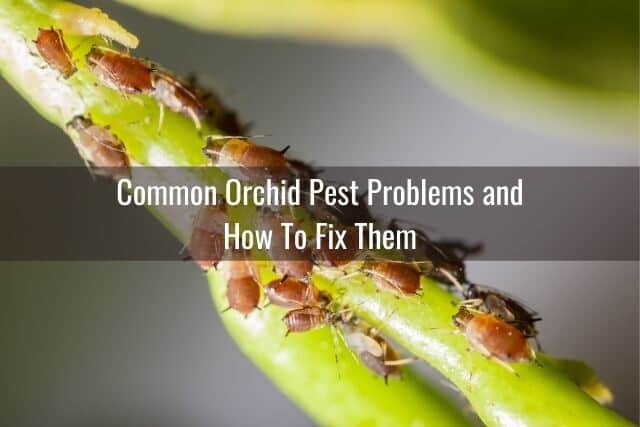
Orchids are susceptible to insect and pest infestation. These are very common problems when growing orchids, especially if the orchids are kept outdoors. This article goes into more detail about how to get rid of pests and insect infestations in your orchid, but here’s a general overview:
Orchid pests include aphids, mealybugs, spider mites, thrips, and scales. Mealybugs, aphids, and scales suck the sap from your orchids, and they can cause leaves to curl and yellow. They can also stunt the growth of leaves and stems, as well as reduce flower production. In addition, these pests excrete honeydew. This is a clear and sticky liquid that attracts ants and black mold fungus.
Aphids and Mealybugs
Aphids (Aphis gossypii) particularly love to live in clusters. They feed on flower spikes, young growths, and developing buds. They can distort your plant. Meanwhile, mealybugs that commonly attack orchids are the citrus mealybugs (Planococcus citri).
Scales
Hard scales like the Boisduval scale (Diaspis boisduvalii) and the Florida red scale (Chrysomphalus aonidum), and soft scales like the brown soft scale (Coccus hesperidum) are most often found on the underside of leaves. These pests feed on the sap.
Spider Mites
Twospotted spider mites (Tetranychus urticae) feed on the underside of leaves and suck the chlorophyll out of the cells of the plant. As such, these pests cause leaves to have a silvery stippled look, with yellow pin-poked dots on them.
These spider mites are greenish-yellow eight-legged bugs with a dark spot on their sides. They attack stressed plants during warm and dry conditions. To detect them early, tap the leaves of your plant over a white sheet of paper. They will drop onto the paper and you will see them crawling around.
Thrips
Many types of thrips will feed on orchids. These include Cuban laurel thrips (Gynaikothrips ficorum), western flower thrips (Frankliniella occidentalis), and greenhouse thrips (Heliothrips haemorrhoidalis). They will feed on flowers and cause deformation, or feed on the buds, which will cause the buds to fail to open. Thrips are hard to see, so you will need a magnifying lens to spot them. To detect them early, blow into an open bloom and watch for the thrips as they crawl inside the flower.
Prevention and Treatment
You can minimize or fix pest problems in orchids through sanitation, inspection, and cultural management strategies. Prevention has been proven to be the best way to manage orchid pests, so always provide your plants proper growing conditions, like adequate water, light, humidity, temperature, and fertilizer.
If pests have infested your plant, your first order of action should be to separate your infected plant from your other plants. This is to prevent the infection from spreading further.
You can treat the infection using insecticides and miticides such as malathion, acephate, chlorpyrifos, bendiocarb, and insecticidal soap. Just make sure to use them properly and follow instructions stated on their packaging.
You also have to wear protective gear and make sure to spray these insecticides in a well-ventilated area and at a safe distance.
Common Orchid Diseases and How To Cure Them
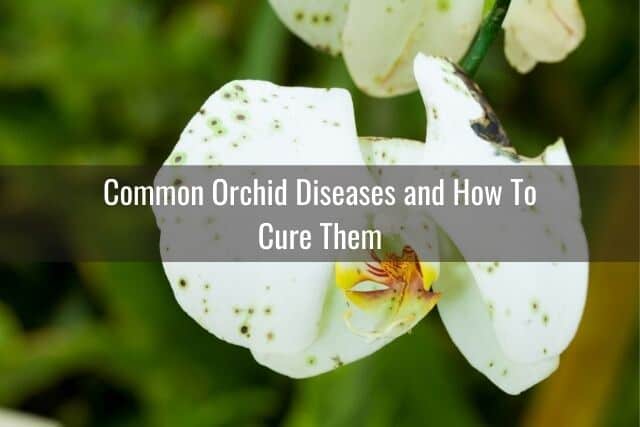
With the many varieties of orchids come many different types of diseases that can afflict them. Most orchid diseases, however, are fungal in nature. A few are bacterial.
The thing is, knowing what type of disease your orchids have will significantly help in treating it. So what are the most common diseases that your orchids might face?
I discuss how to treat mold and fungus infections in orchids in another article, but here is some information about the top fungal, bacterial, and viral diseases in orchids and how to treat them. Unfortunately, these are common problems when growing orchids. Keep reading to learn how to identify and treat these orchid infections.
Fungal Diseases in Orchids and How to Treat Them
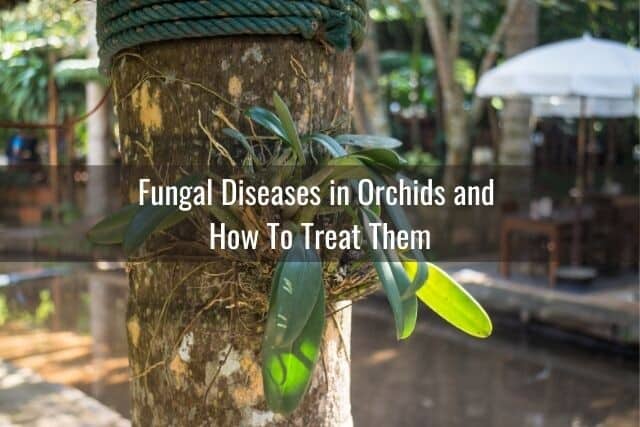
Black Rot
Black rot is very common during extended rainy days. If the orchid is left in standing water, black rot can quickly develop and kill your orchids.
Black rot is mostly caused by two varieties of fungi:
- Pythium ultimum
- Phytophthora cactorum
These fungi attack a wide variety of orchids, but their favorite is Cattleyas. They can only live in places where they can get water. These fungi create zoospores, which can move freely using the flagella. The flagella is a whip-like swimming mechanism.
The fungi that cause black rot not only travel but also reproduce using these zoospores. These zoospores can swim in a pool of water left on an orchid leaf. They will be able to break through the plant tissue and infest the plant.
The fungus will break through the plant tissues and feed off the orchid tissues and put down a mycelium, which is the vegetative part of the fungi, and a mass of hyphae forms it. The inter-networked thread-like hyphae feed off the orchid tissues and steal their nutrients.
The individual hyphae steal nutrients by secreting an enzyme into the orchid’s tissues. These enzymes will break down the tissues into something that the fungi can absorb.
When the fungi attack young orchid plants, the infection is usually close to the soil. Because the orchid base becomes weak, the whole plant may damp off, as the stem and root tissues rot. As a result the plant will topple to the ground and die.
Meanwhile, when the fungi attack mature orchids, the damage is not limited to the base of the plant. It can show up on the roots, pseudobulbs, or leaves.
However, most of the time, you will first notice the black rot developing on new growth, such as the sprouting leads or on young leaves.
Detecting Black Rot in Orchids
Early detection of black rot can help you rescue the orchid. It also prevents nearby plants from getting infected and dying.
When your plant is first infected, you will notice semi transparent, tiny, and watery spots on the leaves. If left untreated, these dark or black spots will become larger and spread quickly.
The blackened areas are often surrounded by yellowed roots or leaves. If you press on these places, they will feel soft, and water will ooze out.
How To Treat Black Rot
If you are dealing with black rot, the best solution is to use a sterilized knife to cut off the affected parts. When you remove the infected areas, be sure to cut some of the healthy tissues surrounding the black spots. This is just to be sure you get all the black rot.
Inspect what remains to ensure that you have gotten all the infected tissues out. This step is crucial when dealing with black rot on pseudobulbs because the infection can extend to the internal tissue. This can happen even when the plant tissue looks healthy on the outside.
If you are treating a monopodial orchid or an orchid that only has one stem, such as a Phalaenopsis orchid, cut the entire leaf if needed. It is important not to let the rot reach the crown. For many stemmed, or sympodial, orchids, you might need to cut the leaf and into the pseudobulb.
Using Chemicals To Treat Black Rot
Merely cutting off the infected parts is not enough to stop black rot. Be sure to use a fungicide to protect your orchids further. Choose products like:
- Garden Safe Brand Fungicide3
- Dr. Earth 8007 Ready to Use Disease Control Fungicide
- Southern Ag 029030 Liquid 32oz Copper Fungicide
If you would rather not spend money, you can use some household items to treat black rot.
For instance, ground cinnamon is a common baking and cooking ingredient and found in many household kitchens. You can rub some ground cinnamon on the cut areas of your orchid plant to protect the orchid from getting reinfected.
Another alternative is mixing cinnamon with cooking oil and applying this concoction to the cut areas of your orchid. This serves to seal out air and prevents microscopic bacteria and fungi from reaching your orchids through the open areas.
Botrytis
Botrytis cinerea causes petal blight. This fungal disease is manifested by tiny circular spots that grow anywhere on the sepals and petals of the flowers. The small spots quickly grow bigger and eventually cause the entire bloom to wilt and die. There are three conditions that help botrytis thrive:
- Damp weather
- Low temperatures
- Poor air circulation
In areas where there are prolonged high levels of humidity and cold temperatures, you may even see a fuzzy growth that is whitish to grayish in color.
Botrytis affects several varieties of orchids. It is more commonly found on Cattleyas and Phalaenopsis.
This particular type of fungus might be hiding on your orchids over the winter. They like to hide in dying or dead plant matter. This is why routine pruning of dead plant matter is so important. Come spring or autumn, they will start making and spreading spores.
When conditions are rife, these spores spread through the air and can get into where your orchids are growing. These spores land on damp orchid surfaces. Once they infect your orchids, otherwise healthy plant tissues can get damaged in just 14 hours.
You can easily prevent a Botrytis infection by ensuring that your orchids are in a well-ventilated area where air circulates freely. Removing any dead plant material from your orchids will also help prevent petal blight. Remove any dead leaves, spent flowers, and other plant material that is dying or decaying.
Furthermore, when you water your orchids, do not wet the flowers or the plant itself. Focus on watering the roots and potting media only. If you leave even a few drops of water on a petal, you create an opportunity for this fungus to grow.
Get into the habit of watering your orchids very early in the morning, perhaps when the sun rises, or a few hours afterward. This will give your orchid enough time to dry off before it gets dark.
Treating and Controlling Botrytis
Once you notice the tiny spots on your orchids blooms, the first thing that you should do is to isolate the plant. This way, the infection will not spread to other plants.
The thing with petal blight is that you cannot remove the spots that have already appeared on the petals. All you can do is to make sure that you use the right fungicide to avoid another round of petal blight in the future.
Most growers, however, do not recommend using a fungicide on the flowers. Decide on whether you would want to risk using pesticides. If you do use pesticides, follow the instructions on how to apply it to the letter.
Root Rot Caused by Rhizoctonia spp
Root rot in orchids can sometimes look like black rot. However, in black rot, the affected areas are soft to touch. When your orchid has root rot caused by Rhizoctonia spp., the blackened area is hard.
Rhizoctonia affects the roots of your orchids. It is not uncommon that most of the telltale signs appear in the aerial roots. These parts become twisted, dry, and shriveled.
The brown root rot is not like black rot because it spreads rather gradually. Root rot can infect your orchids when you overwater them. Rhizoctonia may also be in the potting media which is beginning to decompose.
After the aerial roots become affected, you will see a brownish discoloration gradually creep up the pseudobulbs. The pseudobulb will then turn brown and die.
How To Treat Root Rot
If you notice dry and twisted aerial roots, browning or yellowing pseudobulbs, and the leaves becoming limp and thin, then it is probably root rot.
Take your orchid out of its pot and cut off as much of the diseased roots as possible. Repot your orchid into a newly sterilized pot and use new potting media.
Use a protective fungicide with ingredients such as:
- Thiopahante methyl
- Pyraclostrobin
- Fludioxonil
- Azoxystrobin
- Pentachloronitrobenzene or PCNB
Anthracnose
Anthracnose is a disease caused by viruses, fungi, bacterial pathogens. The two most common pathogens that can affect orchids are:
- Gloeosporium spp.
- Colletotrichum spp.
You will know that your orchid has anthracnose because of the presence of yellowish and light brown spots and lesions on the affected area. In addition, the spores will have a reddish-orange or pinkish hue. They often form rings on the affected area of your orchid.
Anthracnose will have an easier time infecting the orchid when the root systems are weak or if the orchid has been injured or stressed by either cold or hot temperatures.
The good news with anthracnose is that it does not really kill your orchids, but it can make it look bad.
If you want to avoid this disease, then refrain from watering your orchids from overhead. You should also put the plant in a well-ventilated area.
How To Treat Anthracnose
To treat anthracnose, prune the infected leaves off. This will reduce the number of fungi that can attack your plants. Like with other disease treatments, it also helps to spray fungicide such as Physan 20 onto the affected plants.
Viruses in Orchids
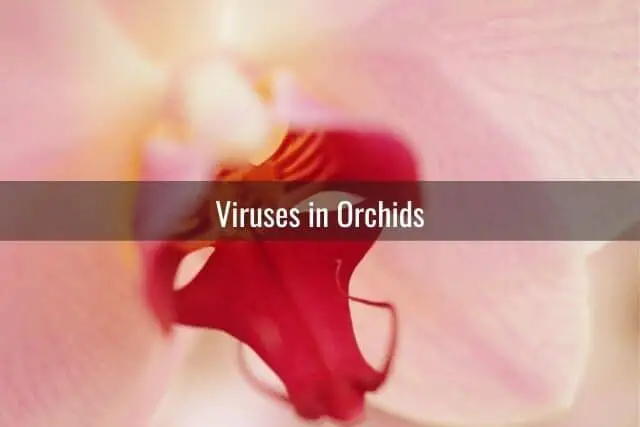
There are viruses that attack orchids as well. More than two dozen viruses are known to affect orchids around the world. The most common are:
- Cymbidium mosaic virus
- Odontoglossum ringspot virus
Viruses can affect your orchids’ health and can result in decreased flower quality.
The thing with viruses is that they are often transmitted together and are difficult to detect. If your orchid suffers from a viral infection, it is sometimes not just one type of virus infecting your orchid, but multiple viruses.
Some orchids may be infected, but they will still look healthy, but less vigorous. The most common symptoms of an orchid viral infection, however, include:
- Leaves developing lesions that are less green.
- Leaves developing necrotic spots.
- The appearance of yellow stripes.
- The appearance of rings and red to yellow lesions.
Detecting viral infections in your orchids can be very difficult because the symptoms may not show up at all. Even if there are signs, these will vary from one genus, species, or variety of orchid to another.
Other things that may affect the symptoms include humidity, temperature, nutrition levels, stress, the plant’s condition, and the types of viruses that attacked your orchids.
For that reason, if you suspect viruses are attacking your plants, it is best to send them to a laboratory for testing. Admittedly, though, this is not always feasible.
The sad news is that when viruses do get to an orchid, there is no way to treat it. It is recommended that you just destroy the orchid lest you risk the virus spreading to your other plants.
Bacterial Infections In Orchids
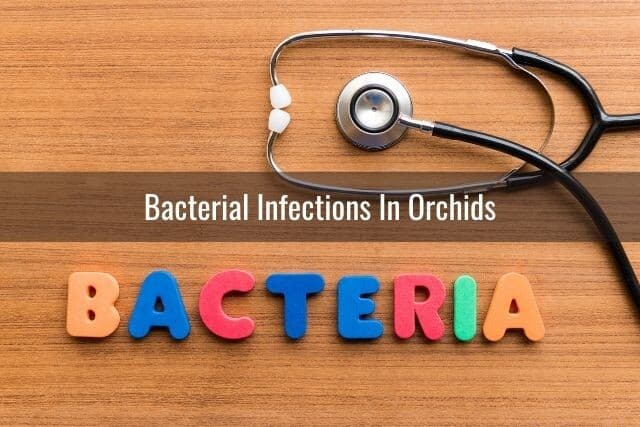
Soft Rot or Brown Rot
Soft rot in orchids is caused by Erwinia spp. This often manifests itself with round and brownish spots that are greasy to the touch. The brown spots will quickly turn into a deep chestnut color.
The spots will have clear margins, and they are also a bit sunken from the surface. If both temperature and humidity are high, brown rot can spread fast, often reaching down to the growing point. At this point, your orchids can topple over.
Be sure to isolate infected orchids immediately because brown rot is highly contagious. You should also disinfect all the tools you used to handle infected plants with bleach or alcohol solutions.
Cut off the infected parts and use a bactericide to prevent further infection and kill the pathogen.
To prevent brown rot, keep your orchid in an area with excellent air circulation. Do not allow its leaves to get wet when you water your plant.
Acidovorax Cattleya
A bacterial infection that affects a variety of orchids, Acidovorax cattleya, can be very contagious. On Cattleya orchids, you will see discoloration appearing on the older leaves. These spots are sunken and black.
On Phalaenopsis orchids, this bacteria can attack seedlings and mature plants alike. The manifestations include a watery green spot on the leaves. This will then start to turn brown before becoming darker brown or black. This bacteria can kill Phalaenopsis orchids.
Because of its highly contagious nature, you should isolate infected orchid plants as soon as you notice the signs of infection. Apply a bactericide that has copper sulfate pentahydrate or benzalkonium chloride as its main ingredients.
To prevent this bacteria from attacking your plant, avoid watering your orchids overhead. Make sure you water your orchids earlier in the day so that the growing media and the plant itself gets the chance to dry off before nightfall.
Nematodes
Foliar nematodes such as the Aphelenchoides spp. can cause your flower buds to remain unopened. Aside from that, the infected buds can be twisted and deformed. It can turn yellow or drop before flowering. If the buds drop prematurely, the leaves may also develop black or brown spots.
Avoid foliar nematodes by watering your orchids properly. Good air circulation can also help stem the spread of nematodes. You can remove those plant parts that are showing signs of nematode infection to stop the disease from spreading.
Tips To Combat Orchid Diseases

Contact or Systemic Fungicides: Which Should You Choose?
Contact fungicides are readily absorbed by the plant surfaces, and they can quickly prevent the spread of the fungi to other plant areas. They also act as a shield when you spray them on the exposed surfaces of plants.
Systemic fungicides penetrate the plant in two ways. First, they can penetrate the orchid on contact. They can also move through the phloem and xylem, which carries food throughout the plant. This means that the entire plant is protected, and the effect of the fungicide is longer lasting than the contact varieties. However, systemic fungicides are more expensive, and most have specialty formulations.
Isolate and Prune
When your orchids have bacterial or fungal infections, the first thing you should do is to isolate the orchid from other plants to avoid infecting healthy plants.
Then diagnose the problem to see what chemicals and manual treatments you should use. Incorrectly diagnosing the pathogen for your plants’ disease will only add unnecessary costs and possibly harm your orchid. For instance, if the orchid has a fungal infection, using bactericides will not help.
Further, it is best to cut off the affected plant areas to prevent the further spread of the pathogen. Remember that it is better to be safe and cut off a portion of healthy tissues than to leave infected plant parts intact.
Final Thoughts
Many problems can arise when you are growing orchids. Identifying the problem correctly can be tricky because, for many issues, the symptoms are similar, such as leaf discoloration. You must do some research and observation when diagnosing and treating your orchids.
Trial and error also plays a role. For instance, you can adjust your watering or relocate your plant and see if there is any improvement. If simple solutions fail, you can proceed to more involved strategies, such as removing your orchid from its pot to inspect the roots or repotting your plant.
However, keep in mind that you will need to act fast with pests and diseases. This is because orchid deterioration can happen quickly in those cases. Treat these problems as soon as possible in order to save your orchid.
If you enjoyed this article, please pin it and share!
